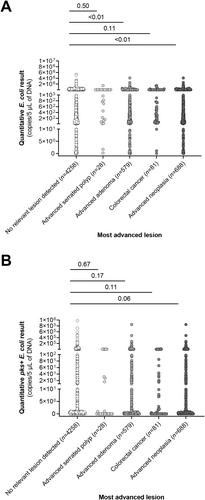Willemijn de Klaver, Meike de Wit, Anne Bolijn, Marianne Tijssen, Pien Delis-van Diemen, Margriet Lemmens, Manon CW Spaander, Evelien Dekker, Monique E van Leerdam, Veerle MH Coupé, Ruben van Boxtel, Hans Clevers, Beatriz Carvalho, Gerrit A Meijer
下载PDF
{"title":"在筛查过程中,一次性测量粪便中的多酮合成酶阳性大肠埃希氏菌并不能说明患结直肠癌的风险。","authors":"Willemijn de Klaver, Meike de Wit, Anne Bolijn, Marianne Tijssen, Pien Delis-van Diemen, Margriet Lemmens, Manon CW Spaander, Evelien Dekker, Monique E van Leerdam, Veerle MH Coupé, Ruben van Boxtel, Hans Clevers, Beatriz Carvalho, Gerrit A Meijer","doi":"10.1002/path.6276","DOIUrl":null,"url":null,"abstract":"<p>Environmental factors like the pathogenicity island <i>polyketide synthase positive (pks+) Escherichia coli</i> (<i>E. coli</i>) could have potential for risk stratification in colorectal cancer (CRC) screening. The association between <i>pks+ E. coli</i> measured in fecal immunochemical test (FIT) samples and the detection of advanced neoplasia (AN) at colonoscopy was investigated. Biobanked FIT samples were analyzed for both presence of <i>E. coli</i> and <i>pks+ E. coli</i> and correlated with colonoscopy findings; 5020 CRC screening participants were included. Controls were participants in which no relevant lesion was detected because of FIT-negative results (cut-off ≥15 μg Hb/g feces), a negative colonoscopy, or a colonoscopy during which only a nonadvanced polyp was detected. Cases were participants with AN [CRC, advanced adenoma (AA), or advanced serrated polyp (ASP)]. Existing DNA isolation and quantitative polymerase chain reaction (qPCR) procedures were used for the detection of <i>E. coli</i> and <i>pks+ E. coli</i> in stool. A total of 4542 (90.2%) individuals were <i>E. coli</i> positive, and 1322 (26.2%) were <i>pks+ E. coli</i> positive. The prevalence of <i>E. coli</i> in FIT samples from individuals with AN was 92.9% compared to 89.7% in FIT samples of controls (<i>p</i> = 0.010). The prevalence of <i>pks+ E. coli</i> in FIT samples from individuals with AN (28.6%) and controls (25.9%) was not significantly different (<i>p</i> = 0.13). The prevalences of <i>pks+ E. coli</i> in FIT samples from individuals with CRC, AA, or ASP were 29.6%, 28.3%, and 32.1%, respectively. In conclusion, the prevalence of <i>pks+ E. coli</i> in a screening population was 26.2% and did not differ significantly between individuals with AN and controls. These findings disqualify the straightforward option of using a snapshot measurement of <i>pks+ E. coli</i> in FIT samples as a stratification biomarker for CRC risk. © 2024 The Authors. <i>The Journal of Pathology</i> published by John Wiley & Sons Ltd on behalf of The Pathological Society of Great Britain and Ireland.</p>","PeriodicalId":232,"journal":{"name":"The Journal of Pathology","volume":"263 2","pages":"217-225"},"PeriodicalIF":5.6000,"publicationDate":"2024-03-29","publicationTypes":"Journal Article","fieldsOfStudy":null,"isOpenAccess":false,"openAccessPdf":"https://onlinelibrary.wiley.com/doi/epdf/10.1002/path.6276","citationCount":"0","resultStr":"{\"title\":\"Polyketide synthase positive Escherichia coli one-time measurement in stool is not informative of colorectal cancer risk in a screening setting\",\"authors\":\"Willemijn de Klaver, Meike de Wit, Anne Bolijn, Marianne Tijssen, Pien Delis-van Diemen, Margriet Lemmens, Manon CW Spaander, Evelien Dekker, Monique E van Leerdam, Veerle MH Coupé, Ruben van Boxtel, Hans Clevers, Beatriz Carvalho, Gerrit A Meijer\",\"doi\":\"10.1002/path.6276\",\"DOIUrl\":null,\"url\":null,\"abstract\":\"<p>Environmental factors like the pathogenicity island <i>polyketide synthase positive (pks+) Escherichia coli</i> (<i>E. coli</i>) could have potential for risk stratification in colorectal cancer (CRC) screening. The association between <i>pks+ E. coli</i> measured in fecal immunochemical test (FIT) samples and the detection of advanced neoplasia (AN) at colonoscopy was investigated. Biobanked FIT samples were analyzed for both presence of <i>E. coli</i> and <i>pks+ E. coli</i> and correlated with colonoscopy findings; 5020 CRC screening participants were included. Controls were participants in which no relevant lesion was detected because of FIT-negative results (cut-off ≥15 μg Hb/g feces), a negative colonoscopy, or a colonoscopy during which only a nonadvanced polyp was detected. Cases were participants with AN [CRC, advanced adenoma (AA), or advanced serrated polyp (ASP)]. Existing DNA isolation and quantitative polymerase chain reaction (qPCR) procedures were used for the detection of <i>E. coli</i> and <i>pks+ E. coli</i> in stool. A total of 4542 (90.2%) individuals were <i>E. coli</i> positive, and 1322 (26.2%) were <i>pks+ E. coli</i> positive. The prevalence of <i>E. coli</i> in FIT samples from individuals with AN was 92.9% compared to 89.7% in FIT samples of controls (<i>p</i> = 0.010). The prevalence of <i>pks+ E. coli</i> in FIT samples from individuals with AN (28.6%) and controls (25.9%) was not significantly different (<i>p</i> = 0.13). The prevalences of <i>pks+ E. coli</i> in FIT samples from individuals with CRC, AA, or ASP were 29.6%, 28.3%, and 32.1%, respectively. In conclusion, the prevalence of <i>pks+ E. coli</i> in a screening population was 26.2% and did not differ significantly between individuals with AN and controls. These findings disqualify the straightforward option of using a snapshot measurement of <i>pks+ E. coli</i> in FIT samples as a stratification biomarker for CRC risk. © 2024 The Authors. <i>The Journal of Pathology</i> published by John Wiley & Sons Ltd on behalf of The Pathological Society of Great Britain and Ireland.</p>\",\"PeriodicalId\":232,\"journal\":{\"name\":\"The Journal of Pathology\",\"volume\":\"263 2\",\"pages\":\"217-225\"},\"PeriodicalIF\":5.6000,\"publicationDate\":\"2024-03-29\",\"publicationTypes\":\"Journal Article\",\"fieldsOfStudy\":null,\"isOpenAccess\":false,\"openAccessPdf\":\"https://onlinelibrary.wiley.com/doi/epdf/10.1002/path.6276\",\"citationCount\":\"0\",\"resultStr\":null,\"platform\":\"Semanticscholar\",\"paperid\":null,\"PeriodicalName\":\"The Journal of Pathology\",\"FirstCategoryId\":\"3\",\"ListUrlMain\":\"https://onlinelibrary.wiley.com/doi/10.1002/path.6276\",\"RegionNum\":2,\"RegionCategory\":\"医学\",\"ArticlePicture\":[],\"TitleCN\":null,\"AbstractTextCN\":null,\"PMCID\":null,\"EPubDate\":\"\",\"PubModel\":\"\",\"JCR\":\"Q1\",\"JCRName\":\"ONCOLOGY\",\"Score\":null,\"Total\":0}","platform":"Semanticscholar","paperid":null,"PeriodicalName":"The Journal of Pathology","FirstCategoryId":"3","ListUrlMain":"https://onlinelibrary.wiley.com/doi/10.1002/path.6276","RegionNum":2,"RegionCategory":"医学","ArticlePicture":[],"TitleCN":null,"AbstractTextCN":null,"PMCID":null,"EPubDate":"","PubModel":"","JCR":"Q1","JCRName":"ONCOLOGY","Score":null,"Total":0}
引用次数: 0
引用
批量引用


 求助内容:
求助内容: 应助结果提醒方式:
应助结果提醒方式:


